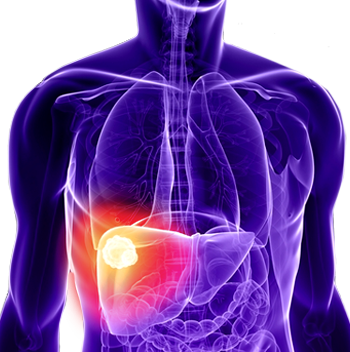BACKGROUND
Liver cancer happens when normal cells in the liver change into abnormal cells and grow out of control. The liver is a big organ in the upper right side of the belly.
Most people who get liver cancer have long-term liver disease (also called chronic liver disease). Having long-term liver disease increases a person’s chances of getting liver cancer. The most common and most serious form of long-term liver disease is a condition called “cirrhosis,” which scars the liver.
DISEASE OCCURRENCE IN POPULATION
Worldwide, the incidence of HCC in developing nations is over twice the incidence of that in developed countries. In developing countries, the mortality from HCC in men is more than double that in developed countries.
Based on results of a reliable hospital-based registry in Pakistan, hepatobiliary cancers are the most common malignancy in adult males and represent 10.7% of all cancers. The age standardized rate for HCC in Pakistan is 7.6 per 100,000 persons per year for males and 2.8 for females.

RISK FACTORS
Factors that increase the risk of primary liver cancer include:
- Gender: Men are more likely to get hepatocellular carcinoma than women.
- Obesity Being obese (very overweight) increases the risk of developing liver cancer. This is probably because it can result in fatty liver disease and cirrhosis.
- Race/ethnicity: In the United States, Asian Americans and Pacific Islanders have the highest rates of liver cancer, followed by American Indians/Alaska Natives and Hispanics/Latinos, African Americans, and whites.
- Chronic infection with HBV or HCV: Chronic infection with the hepatitis B virus (HBV) or hepatitis C virus (HCV) increases your risk of liver cancer.
- Cirrhosis: This progressive and irreversible condition causes scar tissue to form in your liver and increases your chances of developing liver cancer.
- Certain inherited liver diseases: Liver diseases that can increase the risk of liver cancer include hemochromatosis and Wilson’s disease.
- Diabetes: People with this blood sugar disorder have a greater risk of liver cancer than those who don’t have diabetes.
- Nonalcoholic fatty liver disease: An accumulation of fat in the liver increases the risk of liver cancer.
- Exposure to aflatoxins: Aflatoxins are poisons produced by molds that grow on crops that are stored poorly. Crops such as corn and peanuts can become contaminated with aflatoxins, which can end up in foods made of these products.
- Excessive alcohol consumption: Consuming more than a moderate amount of alcohol daily over many years can lead to irreversible liver damage and increase your risk of liver cancer.Scientists have found several risk factors that make a person more likely to develop hepatocellular carcinoma (HCC).
SIGN AND SYMPTOMS
Liver cancer does not usually cause any symptoms of its own. A few patients might have a lump or mild pain in the upper belly, feel full early on when they try to eat, or lose weight.
Others might have symptoms that are caused by the liver disease they had before they got cancer. Those symptoms can get worse or come back because of the cancer. They include:
- Swelling of the belly or legs
- Yellow discoloration of your skin and the whites of your eyes (jaundice)
- Loss of appetite
- Upper abdominal pain
- Nausea and vomiting
- General weakness and fatigue
- Abdominal swelling
- White, chalky stools
If you have these symptoms, tell your doctor or nurse.
Most people don’t have signs and symptoms in the early stages of primary liver cancer. When signs and symptoms do appear, they may include:
DIAGNOSTIC TESTS
s do appear, they may include:
DIAGNOSTIC TESTS
Tests and procedures used to diagnose liver cancer include:
- Blood tests: Blood tests may reveal liver function abnormalities.
- Imaging tests: Your doctor may recommend imaging tests, such as an ultrasound, computerized tomography (CT) scan and magnetic resonance imaging (MRI).
- Removing a sample of liver tissue for testing: Your doctor may recommend removing a piece of liver tissue for laboratory testing in order to make a definitive diagnosis of liver cancer.
During a liver biopsy, your doctor inserts a thin needle through your skin and into your liver to obtain a tissue sample. In the lab, doctors examine the tissue under a microscope to look for cancer cells. Liver biopsy carries a risk of bleeding, bruising and infection.
Determining the extent of the liver cancer
Once liver cancer is diagnosed, your doctor will work to determine the extent (stage) of the cancer. Staging tests help determine the size and location of cancer and whether it has spread. Imaging tests used to stage liver cancer include CTs, MRIs and bone scans.
There are different methods of staging liver cancer. One method uses Roman numerals I through IV, and another uses letters A through D. Your doctor uses your cancer’s stage to determine your treatment options and your prognosis. Stage IV and stage D indicate the most advanced liver cancer with the worst prognosis.
TREATMENT OPTIONS
Liver cancer can be treated in different ways. Treatment depends on the stage of your cancer. It also depends on how healthy your liver is (in other words, how serious your liver disease was before you got cancer). The different treatments include:
Surgery: Liver cancer can sometimes be treated with surgery to remove the part of the liver with the cancer.
Liver transplant: A liver transplant is a type of surgery in which a doctor replaces a diseased liver with a healthy liver from another person.
Ablation therapy: Ablation therapy is a procedure that can kill cancer cells in the liver. It does not involve surgery. Doctors can do ablation therapy in different ways. They can kill the cancer cells using heat, a laser, radiation therapy, or by injecting a special alcohol directly into the cancer.
Blocking the cancer’s blood supply: Doctors can do a procedure called “embolization” to block off the blood vessel that sends blood to the cancer. This keeps the cancer from growing by “starving” it of its blood supply. Sometimes, the embolization procedure is combined with chemotherapy (“chemoembolization”) or radiation (“radioembolization”).
Chemotherapy: Chemotherapy is the medical term for medicines that kill cancer cells or stop them from growing.
Immunotherapy: This is the term doctors use for medicines that work with the body’s infection-fighting system (the “immune system”) to stop cancer growth.
What happens after treatment?
After treatment, you will be checked every so often to see if the cancer comes back. Regular follow up tests usually include exams, blood tests, and imaging tests.
You should also watch for the symptoms listed above. Having those symptoms could mean the cancer has come back. Tell your doctor or nurse if you have any symptoms.
If you had a liver transplant, you will need to take medicines called “anti-rejection medicines” for the rest of your life. These medicines help keep your body from reacting badly to your new liver.
PRECAUTION
Reduce your risk of cirrhosis
Cirrhosis is scarring of the liver, and it increases the risk of liver cancer. You can reduce your risk of cirrhosis if you:
- Drink alcohol in moderation, if at all: If you choose to drink alcohol, limit the amount you drink. For women, this means no more than one drink a day. For men, this means no more than two drinks a day.
- Maintain a healthy weight: If your current weight is healthy, work to maintain it by choosing a healthy diet and exercising most days of the week. If you need to lose weight, reduce the number of calories you eat each day and increase the amount of exercise you do. Aim to lose weight slowly — 1 or 2 pounds (0.5 to 1 kilograms) each week.
- Use caution with chemicals: Follow instructions on chemicals you use at home or at work.
Get vaccinated against hepatitis B
You can reduce your risk of hepatitis B by receiving the hepatitis B vaccine, which provides more than 90 percent protection for both adults and children. The vaccine can be given to almost anyone, including infants, older adults and those with compromised immune systems.
Take measures to prevent hepatitis C
No vaccine for hepatitis C exists, but you can reduce your risk of infection.
- Know the health status of any sexual partner: Don’t engage in unprotected sex unless you’re certain your partner isn’t infected with HBV, HCV or any other sexually transmitted infection. If you don’t know the health status of your partner, use a condom every time you have sexual intercourse.
- Don’t use intravenous (IV) drugs, but if you do, use a clean needle: Reduce your risk of HCV by not injecting illegal drugs. But if that isn’t an option for you, make sure any needle you use is sterile, and don’t share it. Contaminated drug paraphernalia is a common cause of hepatitis C infection. Take advantage of needle-exchange programs in your community and consider seeking help for your drug use.
- Seek safe, clean shops when getting a piercing or tattoo: Needles that may not be properly sterilized can spread the hepatitis C virus. Before getting a piercing or tattoo, check out the shops in your area and ask staff members about their safety practices. If employees at a shop refuse to answer your questions or don’t take your questions seriously, take that as a sign that the facility isn’t right for you.
Ask your doctor about liver cancer screening
For the general population, screening for liver cancer hasn’t been proved to reduce the risk of dying of liver cancer, so it isn’t generally recommended. The American Association for the Study of Liver Diseases recommends liver cancer screening for those thought to have a high risk, including people who have:
- Hepatitis B and one or more of the following apply: are Asian or African, have liver cirrhosis, or have a family history of liver cancer
- Hepatitis C infection and liver cirrhosis
- Liver cirrhosis from other causes, such as an autoimmune disease, excessive alcohol use, nonalcoholic fatty liver disease and inherited hemochromatosis
- Primary biliary cirrhosis
Discuss the pros and cons of screening with your doctor. Together you can decide whether screening is right for you based on your risk. Screening typically involves an ultrasound exam every six months.
REFERENCES
- Luca Cicalese. Hepatocellular Carcinoma. Medscape. https://emedicine.medscape.com/article/197319-overview#a6. Accessed on November 29 2018
- Badar and S. Mahmood, “Hospital-based cancer profile at the Shaukat Khanum Memorial Cancer Hospital and Research Centre, Lahore, Pakistan,” Journal of the College of Physicians and Surgeons Pakistan, vol. 25, no. 4, pp. 259–263, 2015
- Bhurgri, A. Bhurgri, S. H. Hassan et al., “Cancer incidence in Karachi, Pakistan: first results from Karachi Cancer Registry,” International Journal of Cancer, vol. 85, no. 3, pp. 325–329, 2000.
- Y. Bhurgri, A. Bhurgri, S. Pervez et al., “Cancer profile of hyderabad, Pakistan 1998–2002,” Asian Pacific Journal of Cancer Prevention, vol. 6, no. 4, pp. 474–480, 1998.
